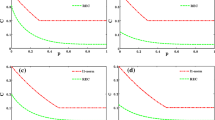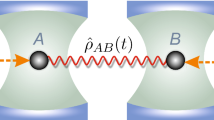Abstract
The uncertainty principle is regarded as one of basics in quantum mechanics, which sets up a strict lower bound to quantify the prediction on the outcome concerning a set of incompatible measurements. In this paper, we investigate the dynamic behaviors of quantum-memory-assisted entropic uncertainty relation (EUR), and quantum coherence in structured reservoir. The results shown that the EUR is smallest in the vanishing limit of noise regardless of the forms of the initial sate we considered, while the coherence keeps the maximal value. During the time-evolution process, the uncertainty bound is lifted and the coherence damps monotonously. Subsequently, the EUR converges to an asymptotic nonzero constant in the long-time limit, yet the coherence asymptotically decays to zero. Moreover, the initial state purity plays a deterministic role in the initial amounts of EUR and coherence, i.e. the larger purity the less EUR and larger coherence. As an application, we employ the EUR to witness the coherence, and prove that the corresponding witnessing efficiencies are only depended on the version of coherence, while are insensitive to the reservoir.



Similar content being viewed by others
References
Heisenberg, W.: Z. Phys. 43, 172–198 (1927)
Nielsen, M.A., Chuang, I.L.: Quantum Computation and Quantum Information. Cambridge University Press, Cambridge (2000)
Einstein, A., Podolsky, B., Rosen, N.: Phys. Rev. 47, 777 (1935)
Robertson, H.: P. Phys. Rev. 34, 163 (1929)
Schrödinger, E. in Proceedings of the Prussian Academy of Sciences, Physics-Mathematical Section XIX, 296 (1930)
Prevedel, R., Hamel, D.R., Colbeck, R., Fisher, K., Resch, K.J.: Nat. Phys. 7, 757 (2011)
Deutsch, D.: Phys. Rev. Lett. 50, 631 (1983)
Hu, M.L., Fan, H.: Phys. Rev. A. 88, 014105 (2013)
Hu, M.L., Fan, H.: Phys. Rev. A. 87, 022314 (2013)
Hu, M.L., Fan, H.: Phys. Rev. A. 86, 032338 (2012)
Kraus, K.: Phys. Rev. D. 35, 3070 (1987)
Maassen, H., Uffink, J.: B. M. Phys. Rev. Lett. 60, 1103 (1988)
Renes, J.M., Boileau, J.C.: Phys. Rev. A. 78, 032335 (2008)
Berta, M., Christandl, M., Colbeck, R., et al.: Nat. Phys. 6, 659 (2010)
Wild M. M. and Renes J. M.: in Proceeding of International Symposium on Information Theory (IEEE, Cambridge, Masschusetts), pp. 334–338 (2012)
Shi, J.D., Ding, Z.Y., Wu, T., et al.: Laser Phys. Lett. 14, 125208 (2017)
Huang A. J.,·Wang D., Wang, J. M. Quantum Inf. Process. 16, 204 (2017)
Renes, J.M., Boileau, J.C.: Phys. Rev. Lett. 103, 020402 (2009)
Ollivier, H., Zurek, W.: H. Phys. Rev. Lett. 88, 017901 (2001)
Henderson, L., Vedral, V.: J. Phys. A. 34, 6899 (2001)
Paula, F.M., de Oliveira, T.R., Sarandy, M.S.: Phys. Rev. A. 87, 064101 (2013)
Cerf, N.J., Adami, C.: Phys. Rev. Lett. 79, 5194 (1997)
Devetak, I., Winter, A.: Proc. R. Soc. A. 461, 207 (2005)
Baumgratz, T., Cramer, M., Plenio, M.: B. Phys. Rev. Lett. 113, 140401 (2014)
Hu, M.L., Hu, X.Y., Peng, Y., Zhang, Y.R., Fan, H.: Phys. Rep. 762-764, 1–100 (2018)
Shi, J.D., Chen, J.J., He, J., Wu, T., Ye, L.: Quantum Inf. Process. 18, 300 (2019)
Man, Z.X., Xia, Y.J., An, N.B.J.: Phys. B. 44, 095504 (2011)
Wu, T., Shi, J.D., Yu, L., et al.: Sci. Rep. 7, 8625 (2017)
Bellomo, B., Franco, R.L., Compagno, G.: Phys. Rev. Lett. 99, 160502 (2007)
Bellomo, B., Franco, R.L., Compagno, G.: Phys. Rev. A. 77, 032342 (2008)
Shi, J.D., Wang, D., Ye, L.: Quantum Inf. Process. 15, 1649–1659 (2016)
Peters, N.A., Wei, T.C., Kwiat, P.G.: Phys. Rev. A. 70, 052309 (2004)
Horodecki, M., Horodecki, P., Oppenheim, J.: Phys. Rev. A. 67, 062104 (2003)
Singh, U., et al.: Phys. Rev. A. 91, 052115 (2016)
Acknowledgments
This work was supported by the National Science Foundation of China under Grant No. 11847020, the candidates of Hefei university academic leader Grant No. 2016dtr02, the Fostering Master’s Degree Empowerment Point Project of Hefei University Grant No. 2018xs03, the Anhui Provincial Natural Science Foundation under Grant Nos. 1908085QA41 and 1908085MA24, the Open Foundation for CAS Key Laboratory of Quantum Information under Grant No. KQI201804, the Research Center for Quantum Information Technology of Fuyang Normal University under Grant No. kytd201706, the horizontal cooperation project of the people’s Government of Fuyang City-Fuyang Normal University under Grant No. XDHX201708, and also by the Doctoral Foundation of Fuyang Normal University under Grant No. 2017kyqd0013.
Author information
Authors and Affiliations
Corresponding author
Additional information
Publisher’s Note
Springer Nature remains neutral with regard to jurisdictional claims in published maps and institutional affiliations.
Appendix
Appendix
Here, we revisit the physical model with the interaction of single qubit+reservoir system and the global evolution of composite system. The physical model is that the single qubit is locally interacted with a multimode reservoir, and the corresponding Hamiltonian is (ℏ = 1) [27, 28].
where gj is coupling constant between the qubit and reservoir mode j, x†(x) is the creation (annihilation) operator of the reservoir with frequency ωj, \( {\sigma}_{+}^X=\left|1\right\rangle \left\langle 0\right| \) and \( {\sigma}_{-}^X=\left|0\right\rangle \left\langle 1\right| \) are the qubit rising operator and lowering operator acting on the Xth qubit with transition frequency ω0 in the orthogonal computational basis {|0〉, |1〉}. The evolution of single qubit+reservoir subsystem depends on the choice of Lorentzian spectral density of the reservoir. To do it, the Lorentzian spectral distribution we taken is of the following form
The parameter R is connected to the qubit+cavity coupling strength and Γ denotes the half-width at half-maximum of the intracavity field spectrum profile. Moreover, their relative magnitudes determine the Markovian (Γ > 2R) and the non-Markovian (Γ < 2R) regimes, respectively.
In terms of the reservoir Hamiltonian (6) and Lorentzian spectral distribution (7), the interaction of single qubit+reservoir can be computationally formulated, which are
where \( \xi (t)={e}^{-\varGamma t/2}\left[\cosh \left(\frac{dt}{2}\right)+\frac{\varGamma }{d}\sinh \left(\frac{dt}{2}\right)\right] \) with \( d=\sqrt{\varGamma^2-4{R}^2} \). Here, we point out that form the independent qubit+reservoir system the analytical solutions of quantum states can be derived for arbitrary initial states.
When qubits A and B are initially prepared in the EWL state and reservoirs a and b are initially in the vacuum states \( {\left|\overline{0}\overline{0}\right\rangle}_{ab} \), the initial density matrix of the total qubit+reservoir system thus reads
which will evolve to
with
where ξ0(t) = ξ(t) and \( {\xi}_1(t)=\sqrt{1-\xi {(t)}^2} \). By tracing over the reservoir freedom, we can obtain the reduced density matrix for the qubit subsystem ρAB(t), yielding
Rights and permissions
About this article
Cite this article
Fang, BL., Shi, J. & Wu, T. Quantum-Memory-Assisted Entropic Uncertainty Relation and Quantum Coherence in Structured Reservoir. Int J Theor Phys 59, 763–771 (2020). https://doi.org/10.1007/s10773-019-04363-6
Received:
Accepted:
Published:
Issue Date:
DOI: https://doi.org/10.1007/s10773-019-04363-6




